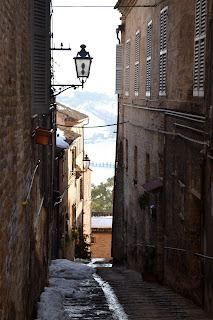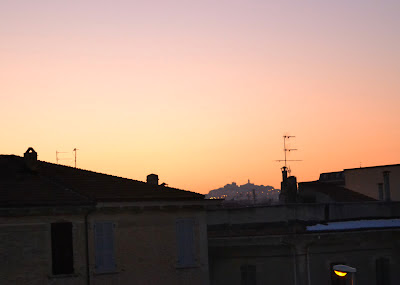Osimo and Bologna
On Sunday, February 19, we were treated to a tour of another hill town, Osimo. The town was founded by Greek colonists and later conquered by the Romans. It eventually became part of the Papal States until the reunification of Italy in 1861. Cristina's good friend Gianluca lives in Osimo and he invited us to his home where we had a delicious lunch of lasagna, pastries and, of course, wine.
 |
| Adam, Cristina, Gianluca and I in Osimo town sqaure |
 |
| fountain in the town square |
 |
| street in Osimo |
 |
| day after concert unwinding |
After lunch and a quick tour of Osimo, we left for Bologna from Ancona, a seaport town north of Civitanova Marche and Osimo. We had tickets for a 4:30 train to Bologna. I was very pleased that I had easily booked the tickets online and got us assigned seats. What I didn't remember is that there were two trains to Bologna leaving within minutes of each other. We were booked on the second train, but when I saw a train coming that said Bologna (it was on the same track), I told everyone that was our train. We had to run to the other end of the train because our seats were located in car 7. We jumped on the train at car 6 since the train was about to leave, knowing we could get to car 7 through car 6. However, when we got to the end of car 6, we realized there was no car 7. Thankfully, Cristina used her command of the Italian language and found that we were on the wrong train. So we all jumped off quickly, dragging our luggage through the train with the conductor giving us nasty looks and some choice Italian phrases. It was definitely a scene out of the Chevy Chase movie
European Vacation! Once we were back on the platform and had caught our breath, we had a good laugh.
 |
| Cristina and Adam relaxing finally on the right train |
Even though I had visited other cities in Italy, I didn't know much about Bologna and I was looking forward to learning more. These few pictures and descriptions can only give a snapshot of everything the city of Bologna has to offer. Besides being a large university city, it has spectacular history, art, music, culture and cuisine. We stayed in the heart of the medieval part of Bologna and we could walk all over the city without having to take a cab. Bologna had just experienced a snowstorm and you can see the remains of the snow in the Piazza Maggiore, Bologna's main square.
 |
| Piazza Maggiore |
 |
| an example of Bologna's archways |
Bologna is famous for it's porticos. It has over 25 miles of porticos around the city. They were originally built to create more living space. Bologna's university was world famous and had attracted thousands of immigrants. In order to have more living space, the people began to build extensions to their buildings. They were built out over the sidewalks. The first portico dates to 1211. It soon became a requirement to build a portico if you built a new building. These archways protect from the sun in the summer and from rain and snow in the winter. The first day we were in Bologna was cold and rainy. The archways were a wonderful way to walk around the city on a rainy day.
 |
| Piazza del Nettuno with Neptune fountain in the background |
The Neptune fountain is a well known sculpture in Bologna dating back to 1563. The fountain was considered a profane, pagan symbol by the papal authorities.
After Tom flew back to London on Monday, Adam, Cristina and I had some time to explore Bologna. We found a wonderful store filled with all kinds of music so we had to stop and peruse the shelves for awhile. It's hard to find this quality of music store in the U.S.
perusing a music store
Tom and I happened to walk by this amazing university library. Bologna's university was officially founded in 1088 and claims to be the oldest in the western world. The library that we found had ceilings of monuments to lawyers, doctors and other professions. It is still the center for law study in Italy.
Rossini's Stabat Mater was first performed in this hall. Seeing this hall was exciting to me because I had sung the Stabat Mater a year ago with the Cleveland Orchestra Chorus.
 |
| the entrance to the Stabat Mater Hall |
 |
The ceiling as you come
up the stairs in the library |
Bologna is a food lover's paradise. The food is reasonably priced and even in the smaller trattorias, the food was excellent. Tortellini and tagliatelle are original to Bologna. Not too far from Bologna is Parma, the origins of Parma ham, Parmesan cheese and Balsamic vinegar. This is a picture of our first meal in Bologna at Trattoria Anna Maria. Outstanding!
 |
| Tagliatelle with Bolognese sauce |
 |
| a display in a pastry shop |
 |
| all varieties of tomatoes were out on this sunny day |
 |
| olives, cheeses, mortadella, parma ham. |
I took this picture of tortellini in a pasta store. I learned that tortellini is typically made with meat or cheese and smaller than tortelloni. Tortellini in brodo is a common way to eat tortellini,
which is simply tortellini in a broth AND it's simply delicious.
 |
| Our extended weekend in Italy is over. We will take wonderful memories with us of fantastic food, marvelous music, and good times with friends and family. |










































